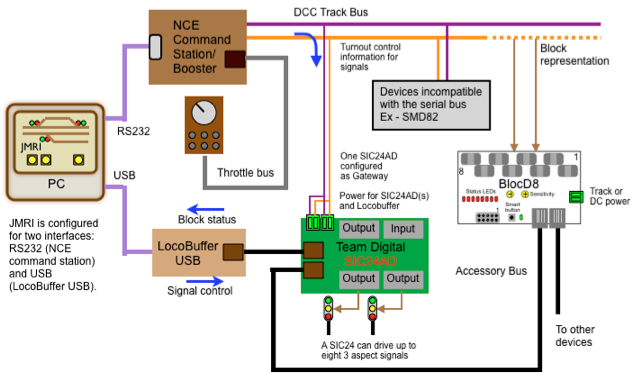Signal System with BlocD8
General Operation:
This scheme provides for a signal system with Team Digital SIC24e(s) and BlocD8(s) in a NCE DCC system. Turnout control is available via a throttle and JMRI. It demonstrates the concept of an accessory bus.
An accessory bus also called serial bus is defined as an independent serial bus separate from the throttle bus. This can provide several advantages for a DCC system. One of the big advantages of an accessory bus is that it provides a "two way street" for accessories to communicate with each other. With regard to accessories DCC is a "one way street". That is, control information is sent from the command station in the form of DCC packets on the track bus. Accessories monitor this information and respond to instructions with their address. There is no provision for accessories to "talk back" to the command station via DCC. Also, an accessory bus can expand the selection of devices available for applications and can aid in trouble shooting.
Panel Display:
The panel display is depicted on a computer screen using software like JMRI. It allows the display of layout status via the accessory bus.
JMRI is capable of having more than one interface. In this case the computer is shown connected to the NCE command station via RS232 and connected to the accessory bus via a USB cable and a LocoBuffer USB. JMRI must be configured for a NCE interface and LocoNet® interface since the accessory bus is compatible with Digitrax's LocoNet® .
Power:
The SIC24e(s) and BlocD8(s) may be powered from a dedicated power supply or the track. Using the rail sync lines in a separate accessory bus provides easy power connections for multiple devices. The Locobuffer can also be powered from rail sync.
Note: SIC24 is sometimes used to refer to the original SIC24, the SIC24AD and SIC24e. The original SIC24 can NOT be powered from the track.
NCE DCC system with signal control
